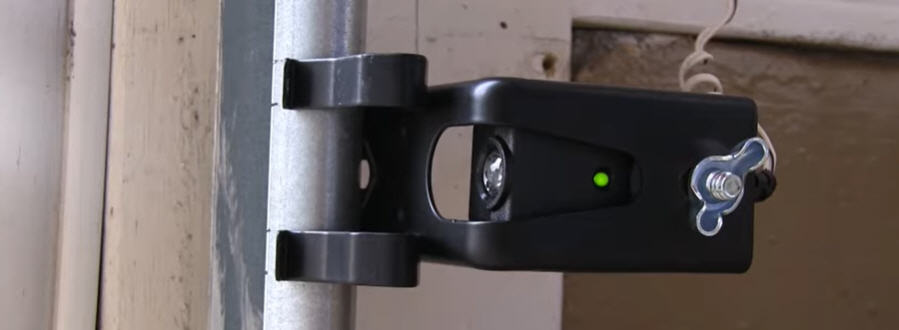Are your garage doors failing to close or opening/closing intermittently or unpredictably?
The cause could be the little lights – called sensors – near the bottom of your garage door tracks.
What is the purpose of Garage Door sensors?
Garage door sensors, also known as garage door safety sensors or photoelectric sensors, serve a crucial safety function in automated garage door systems. They are typically installed near the bottom of the garage door tracks, on either side of the door.
The purpose of these sensors is to detect obstructions or objects in the path of a closing garage door. They work by transmitting an infrared beam of light between the two sensors. When the beam is interrupted by an object, such as a person, pet, or vehicle, the sensors detect the obstruction and signal the garage door opener to stop closing and reverse its operation, preventing accidents and damage.
In essence, garage door sensors help ensure the safety of people and property by preventing the door from closing on anything in its path, thereby reducing the risk of injury or property damage. They are a critical component of modern garage door systems and are mandated by safety regulations in many jurisdictions.
What should the Sensors look like when in or out of Alignment?
When garage door sensors are in alignment and functioning properly, they should be positioned facing each other with their infrared beams unobstructed. Here’s what they should look like when aligned:
- Indicator Lights: Many garage door sensors have indicator lights on them. When aligned, both sensors typically have solid indicator lights, indicating that the infrared beam is unobstructed and the sensors are communicating properly.
- No Obstructions: When you look at the sensors from one side to the other, you should see a clear path between them. There shouldn’t be anything blocking the path of the infrared beam.
- Direct Alignment: The sensors should be directly facing each other and mounted at the same height. They are usually positioned a few inches above the ground, close to the bottom of the garage door tracks.
- Visual Inspection: Visually inspect the sensors to ensure they are clean and free from any debris, dirt, or other obstructions that could disrupt the infrared beam.
When garage door sensors are not in alignment or malfunctioning, there are several signs you may notice:
- Blinking Indicator Lights: One or both sensors may have blinking or flashing indicator lights, indicating a misalignment or communication issue.
- Misalignment: The sensors may not be directly facing each other or may be mounted at different heights.
- Blocked Beam: There may be an object obstructing the infrared beam between the sensors.
- No Indicator Lights: If the indicator lights are off or not illuminated at all, it could indicate a power issue or a malfunction with one or both sensors.
- Inconsistent Operation: The garage door may not close properly or may reverse unexpectedly, even when there are no visible obstructions in the door’s path.
If you notice any of these signs, it’s important to realign the sensors and ensure they are functioning correctly to maintain the safety of your garage door system.
What Happens when the Sensors are out of Alignment or not Working?
When garage door sensors are out of alignment or malfunctioning, several negative symptoms can occur, potentially compromising the safety and functionality of the garage door system:
- Failure to Close: One of the most noticeable symptoms is that the garage door may fail to close properly. When the sensors are misaligned or obstructed, the garage door opener may detect this as an obstruction in the door’s path, causing it to halt or reverse its operation.
- Intermittent Closing: The garage door may exhibit intermittent closing behavior, where it closes partially but then reverses unexpectedly. This can happen if the sensors momentarily lose alignment or communication with each other.
- Unpredictable Operation: When the sensors are out of alignment, the garage door opener’s safety mechanism may become unpredictable. It may sometimes close the door despite an obstruction or fail to close the door when the path is clear.
- Safety Risk: Misaligned sensors compromise the safety of the garage door system. If the sensors fail to detect obstructions due to misalignment, there is an increased risk of the door closing on objects, pets, or people, potentially causing injury or property damage.
- Increased Wear and Tear: If the garage door repeatedly attempts to close but is halted or reversed due to misaligned sensors, it can lead to increased wear and tear on the door opener mechanism. This can shorten the lifespan of the opener and require more frequent maintenance or repairs.
- Inconvenience: Dealing with a malfunctioning garage door can be inconvenient and frustrating for homeowners. Having to manually intervene to close the door or experiencing repeated interruptions in its operation can disrupt daily routines and activities.
Misaligned garage door sensors can lead to various negative consequences, including safety risks, operational issues, and increased maintenance needs. It’s essential to promptly address any misalignment or malfunctioning of garage door sensors to ensure the safe and reliable operation of the garage door system.
 How Can I Re-align My Garage Door Sensors
How Can I Re-align My Garage Door Sensors
If you are unable to re-align your sensors, please contact Garage Doors & More or give us a call at 479-250-2069. We are located in Bentonville, Arkansas.


